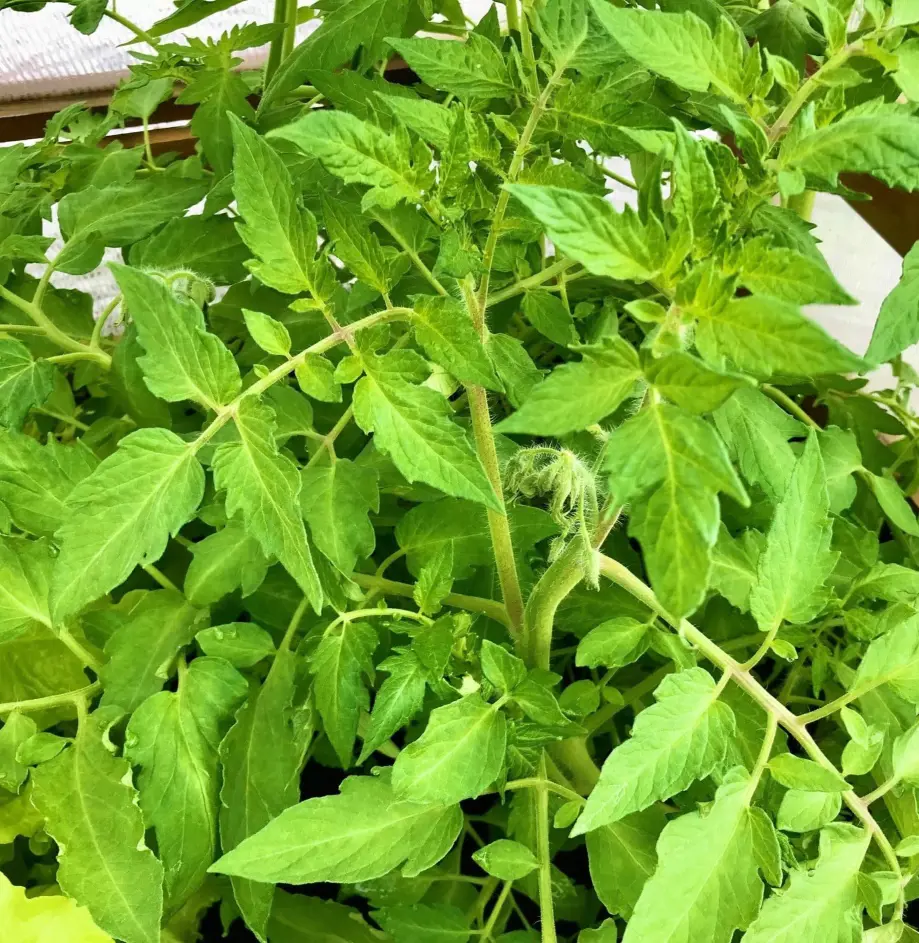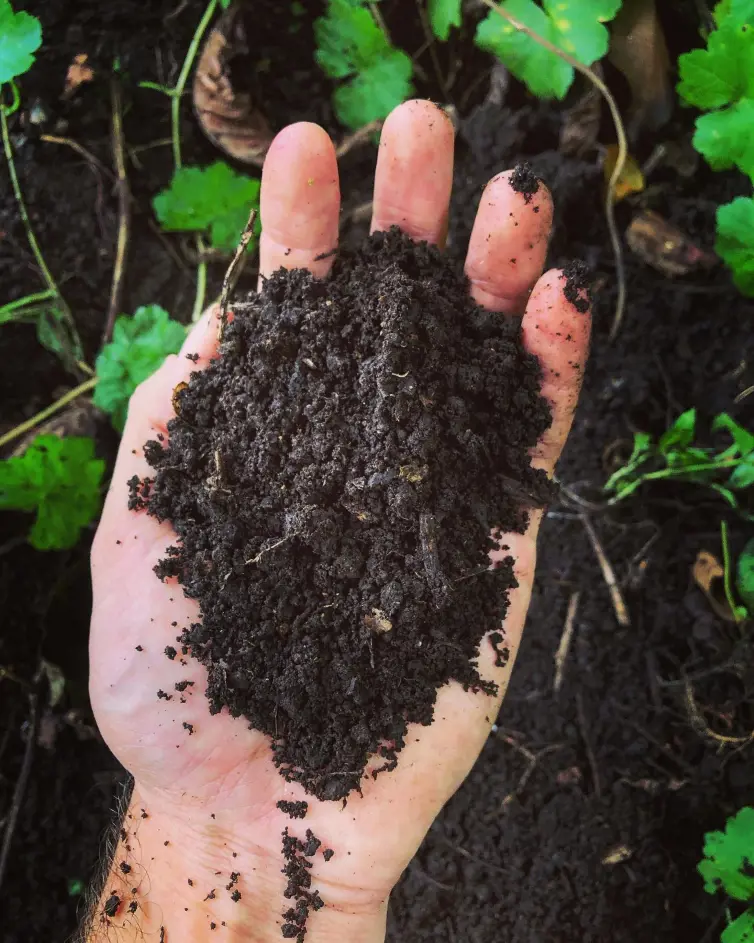Tomato Leaf Curling Causes and Effective Remedies

This post may contain affiliate links. If you make a purchase through links on our site, we may earn a commission.
Curling tomato leaves can strike fear into the hearts of any gardener. Those once-proudly unfurled leaflets, vital for photosynthesis and fruit production, suddenly twist and contort, casting a shadow over your tomato dreams.
Curling isn't always a death sentence. In many cases, with a little curling, your plants can bounce back and thrive. This guide is here to identify the causes and bring your tomato plants back to their flourishing glory.
Understanding Tomato Leaves Curling

Tomato leaves curling up can be a worrisome sight for any gardener. But before you panic, it's important to understand the "why" behind this phenomenon. By delving into the various causes and their telltale signs, you can diagnose the problem and take steps to revive your precious tomato plants.
Leaf curl is a plant's response to stress. It's a way to conserve water, protect itself from harsh sunlight, or ward off pests and diseases. By understanding the different types of stress, you can narrow down the culprit and take appropriate action.
Different Types of Leaf Curl
Upward Curl:
- Description: Leaves curl upwards along their edges, resembling spoons or canoes.
- Causes: underwatering, nutrient deficiency, and herbicide damage.
Downward Curl:
- Description: Leaves curl downwards and inwards, appearing like claws or fists.
- Causes: overwatering, pests, and fungal disease.
Inward Curl:
- Description: Leaves roll inward tightly, forming tubes or cylinders.
- Causes: viral disease, herbicide damage, and environmental stress
Twisting and Distorting:
- Description: Leaves twist and contort in irregular shapes, losing their normal flat form.
- Causes: nutrient deficiencies, pests, and herbicide damage.
Marginal Curl:
- Description: Only the edges of the leaves curl upwards or downwards, while the central part remains relatively flat.
- Causes: wind damage, nutrient imbalances, and water stress.
The specific cause of leaf curl can vary depending on the plant species, environmental conditions, and other factors. Consulting a gardening expert or taking a leaf sample to a local nursery can help pinpoint the exact problem and determine the best course of action for your plants.
Common Causes of Tomato Leaf Curl
Tomato leaf curl is a common disorder in tomato plants that manifests as the upward curling or rolling of the leaves. There are several potential causes for this condition, and it's often a combination of factors rather than a single issue. Here are some common causes of tomato leaf curl:
Environmental Stress:

- Underwatering and overwatering:
- Underwatering: When thirsty, tomatoes prioritize water conservation. Leaves curl inwards to minimize water loss, resembling rolled-up cigars. Look for dry, brittle foliage and wilting stems.
- Overwatering: Excess water can damage roots, hindering water uptake and causing leaves to curl upward like spoons. Watch for yellowing foliage, and wilting despite wet soil, and waterlogged soil.
- Excessive heat and sun exposure:
- Under scorching sun and high temperatures, leaves curl up to minimize surface area and reduce water loss. Observe for leaves with scorched edges and overall wilting.
- Nutrient Deficiency or Imbalance:
- Lack of essential nutrients like nitrogen, potassium, and magnesium can lead to leaf curl. Look for specific symptoms depending on the deficient nutrient:
- Nitrogen: yellowing leaves, stunted growth.
- Potassium: curling, cupping, and browning of leaf edges.
- Magnesium: yellowing between leaf veins, with green edges.
- Lack of essential nutrients like nitrogen, potassium, and magnesium can lead to leaf curl. Look for specific symptoms depending on the deficient nutrient:
- Wind Damage and Physical Stress:
- Strong winds can tear and curl leaves. Look for ragged edges, bruising, and broken stems.
Pests and diseases:

- Aphids, Whiteflies, and Other Sucking Insects:
- These pests feed on plant sap, causing leaves to curl and distort. Look for insects on the undersides of leaves and sticky sap deposits.
- Fungal Infections and Leaf Blight:
- Fungal diseases like early blight and septoria leaf spots can cause leaves to curl, twist, and develop brown or black lesions.
-
Viral diseases like Tomato Yellow Leaf Curl Virus:
-
This virus, transmitted by whiteflies, causes severe leaf curling, yellowing, and stunting.
-
Cultural Practices and Mistakes:
- Improper Planting Depth and Spacing:
- Planting too deep can bury stems and stress the plant, leading to leaf curl. Too-close spacing can restrict air circulation and promote fungal diseases.
- Overly deep or shallow planting:
- Deep planting can hinder root development and water uptake, while shallow planting can expose roots to drying and sun damage, both of which cause leaf curl.
- Damage During Transplanting:
- Rough handling or root disturbance during transplanting can stress the plant, causing a temporary leaf curl.
Now, let us explore this step-by-step guide on how to fix tomato leaf curling:
Examine the Leaves

Begin by inspecting the tomato plants thoroughly. Look for any visual cues that might explain the leaf curling, such as discoloration, spots, or deformities.
Examining the entire plant will help you determine whether the issue is widespread or localized.
Tips:
- Use a magnifying glass to inspect the leaves more closely.
- Look for patterns such as upward or downward curling and compare them with online resources for specific issues.
Check for Pests
Pests can be a common culprit for leaf curl. Look for signs of infestation, such as small insects, webbing, or distorted growth. Common pests affecting tomatoes include aphids, mites, and whiteflies.
If detected, use insecticidal soap or neem oil to eliminate the pests and prevent further damage. Plant tomato companion plants to deter pests and encourage growth.
Tips:
- Introduce beneficial insects like ladybugs that feed on harmful pests.
- Spray plants with a strong stream of water to dislodge small pests.
Watering Practice
Inconsistent watering can lead to stress and subsequent leaf curls. Ensure that your plants receive a consistent and adequate water supply. Water deeply, and avoid letting the soil dry out completely between watering sessions.
Overwatering, however, should be avoided, as it can lead to root-related problems.
Tips:
- Water in the morning to allow foliage to dry during the day, reducing the risk of fungal diseases.
- Consider using a drip irrigation system for consistent and efficient watering.
Soil Quality

Conduct a soil test to assess nutrient levels. Imbalances or deficiencies in nutrients can result in leaf curl.
Address nutrient deficiencies by amending the soil with a balanced fertilizer, paying attention to the specific needs of tomato plants regarding nitrogen, phosphorus, and potassium.
Tips:
- Perform regular soil tests throughout the growing season to monitor nutrient levels.
- Incorporate organic matter into the soil to improve its overall structure and nutrient content.
Temperature and Sunlight
Tomatoes are sensitive to extreme temperatures. Ensure your plants receive sufficient sunlight, ideally 6–8 hours per day.
If the weather becomes excessively hot, consider providing some shade during the peak hours to alleviate stress on the plants and reduce the risk of leaf curl.
Tips:
- Install temporary shade cloth during extreme heatwaves.
- Use reflective mulch to enhance sunlight exposure for plants.
Pruning

Pruning is essential to remove diseased or overcrowded foliage. Use clean, sharp pruning shears to cut away any yellowing or damaged leaves.
Additionally, prune the lower branches to improve air circulation. This helps prevent the spread of diseases like early blight, which can lead to leaf curl.
Tips:
- Disinfect pruning tools between cuts with a solution of one part bleach to nine parts water to prevent the spread of diseases.
- Focus on removing the oldest, lowest branches that are more susceptible to diseases.
- Allow some suckers to develop into secondary stems to increase fruit production.
Mulching
Apply a layer of organic mulch, such as straw or shredded leaves, around the base of the plants. Mulch helps conserve soil moisture, suppress weeds, and regulate soil temperature.
This is particularly beneficial during hot weather, as it prevents the soil from drying out too quickly.
Tips:
- Leave a small gap between the mulch and the base of the plant to prevent moisture-related diseases.
- Replenish the mulch layer as needed to maintain a consistent depth throughout the growing season.
Disease Management
For fungal diseases, copper-based fungicides are effective. Please apply the fungicide according to the manufacturer's instructions and ensure thorough coverage of both sides of the leaves.
For viral diseases, prevention is key, so focus on controlling pests and practicing good garden hygiene. Ensure proper management of these pot-growing vegetables to prevent leaf curling.
Tips:
- Apply fungicides preventatively during periods of high humidity to reduce the risk of fungal infections.
- Quarantine new plants before introducing them to your garden to prevent the spread of diseases.
Adjusting pH Levels

Conduct a soil pH test using a reliable kit. If the pH is too high (alkaline), amend the soil with agricultural sulfur. If it's too low (acidic), use lime to raise the pH.
Tomatoes generally prefer a slightly acidic soil pH between 6.0 and 6.8 for optimal nutrient uptake.
Tips:
- Test the soil pH in multiple locations within your garden to account for potential variations.
- Adjust the pH gradually over multiple seasons, rather than making drastic changes all at once.
Monitor Progress
After implementing changes, monitor your tomato plants regularly. Keep an eye on new growth and observe whether the symptoms are improving. Be patient, as it may take some time for the plants to recover.
Adjust your care practices as needed based on the ongoing health of the plants.
Tips:
- Keep a gardening journal to track changes, treatments, and observations for future reference.
- Consider using a plant monitoring app or tool to help track growth patterns and receive timely reminders for care tasks.
Additional Tips and Tricks for Healthy Tomato Plants

Here are some additional tips and tricks to ensure the overall health and productivity of your tomato plants:
Go Beyond the Basics:
- Seedling Strength: Don't coddle your seedlings! Expose them to gradually increasing sunlight and cooler temperatures before transplanting. This strengthens their stems and prepares them for the outdoors.
- Deep Root Watering: Instead of frequent shallow watering, give your plants a deep soak every 7–10 days. This encourages roots to go deeper, accessing more water and nutrients.
- Calcium Boost: Blossom end rot, a common tomato issue, can be prevented by ensuring adequate calcium uptake. Apply calcium nitrate or crushed eggshells to the soil around the base of plants.
Get creative with companions:
- Plant Marigolds Nearby: These vibrant flowers not only add beauty, but their pungent scent deters harmful pests like aphids and whiteflies.
- Attract Beneficial Insects: Interplant your tomatoes with herbs like dill and chives, which attract ladybugs, lacewings, and other beneficial insects that prey on garden pests.
- Build a Bat Hotel: These winged allies are nature's mosquito and beetle assassins. Hang a bat hotel in your garden to encourage these nocturnal pest-gobblers.
Think Beyond the Soil:
- Foliar Feeding: Give your plants a quick nutrient boost by misting their leaves with a diluted organic fertilizer or seaweed extract. This is especially helpful in hot, dry weather when soil absorption can be limited.
- Sun Stress Protection: During peak heat hours, spray your plants with a light mist of water to cool them down and prevent sun scorching.
- Homemade Pest Repellents: Instead of harsh chemicals, try natural pest deterrents like garlic spray or chili pepper solution. These can be effective against aphids, thrips, and other soft-bodied insects.
Recent posts
Gardening
Gardening
How To Grow Grass From Seed? Planting And Caring Guide
Growing grass seems like an easy task. But the ones who are already into it know how much work and patience is required for its maintenance, to transform the outdoor space into a lush, green oasis. For beginners who are starting from scratch or someo...
Gardening
How To Grow, Plant And Care Milkweed From Seed
Planting milkweed from seed is one of the most satisfactory practices. It not only adds value to your garden aesthetics but also contributes essential instinct pollinators, including monarch butterflies. Many milkweed seeds germinate best when expos...
Gardening
18 Rose Colors And Their Meanings
Roses are not only elegant flowers but they also represent something more profound. Every color of a rose has its special meaning, making it a powerful tool when it comes to conveying messages in personal relationships and occasions. Ranging fr...
Gardening
When To Plant Vegetables – A Month By Month Calendar
Understanding when to plant vegetables is essential to successful gardening as timing alone can greatly affect the productivity and health of vegetables. A month-by-month planting calendar is useful because not every month is ideal for a specific pro...
Gardening
How To Prune Hydrangeas So That It Stays Healthy
The name hydrangea conjures clusters of flowers packed densely. Hydrangeas can grow in both old and old wood, and depending on the varieties, pruning time may differ. Pruning hydrangeas is a fundamental practice for gardeners wanting to maintain thei...
Gardening
How To Prune Roses With These 10 Steps
Pruning these thorn-filled plants might seem scary, but it's crucial for having abundant rose blooms. Cutting back old growth encourages new, vibrant growth, removes dead parts, and shapes the plant. This practice also reduces the risk of fungal dise...







